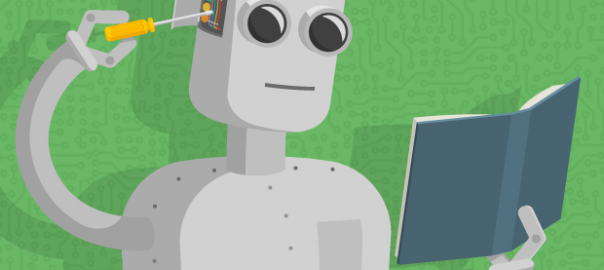A calculator can solve complex problems which would take even the most savvy mathematicians an incomparable amount of time. Artificial intelligence has become one of the most hotly debated and highly funded aspects of technology because the speed at which machines can process information yields innumerable possibilities and applications which can and will benefit humanity. One of the first popular incarnations of AI is Machine Learning.
Machine Learning is the ability for a computer to learn without being explicitly programmed. Machine learning focuses on computer programs which can identify patterns and create its own algorithms when exposed to new data. It is used in self-driving cars, in newsfeed algorithms on social media, in evaluating job candidates, in recognizing faces on your phone, and more.
The most powerful form of machine learning currently active is called “deep learning”. “Deep learning” builds a complex mathematical structure known as a neural network out of vast quantities of data. Machine learning’s ability to handle mass amounts of data makes it crucial to the advancement of IoT. The IoT collects enormous amounts of data which require computers with machine learning to recognize patterns and create algorithms. In self-driving cars, IoT cameras and sensors in each autonomous vehicle absorb their surroundings and turn them into huge amounts of data. The data is then sent to the cloud where it is accessible to all autonomous vehicles on the road. Thus, when one self-driving car makes a mistake, all of them learn. In conjunction with the Internet of Things, machine learning will be vital to the building of a smartworld.
TOP PROGRAMMING LANGUAGES
Machine learning requires a great deal of statistical analysis; it demands an intelligent programming language which can process a number of complex issues and general paradigms.
R: Considered a statistical workhorse, R has emerged as one of the top programming languages for machine learning. R is intended for advanced users because of its complex nature and wide learning curve.
Python: A rising star for machine learning, Python is a data science book which has been in use in the manufacturing industry for awhile. Python gives users direct access to predictive analytics, making it the foremost data science language. Developers turn to Python when they are looking to frame better questions or expand the capabilities of their existing machine learning systems.
MATLAB/Octave: Millions of engineers are already using MATLAB, a matrix-based language, to analyze and develop cutting edge systems. MATLAB has emerged as the simplest way to demonstrate computational mathematics.
MACHINE LEARNING AND iOS 10
Machine learning laid much of the groundwork for the biggest upgrade in iOS 10. It is very difficult for computers to comprehend the intricacies of the human language. Machine learning has enabled iPhones to sense contextual clues with increasing confidence, improving iMessage’s ability to autocorrect and for Siri to understand the particulars of your vernacular. In the iPhone 7 camera, machine learning allows the device to separate the background from the foreground to achieve amazing portraits once possible only with DSLR cameras.
MACHINE LEARNING AND ANDROID
Google is among the dominant forces in machine learning. Much of Google Search’s prominence is owed to advances in the machine learning field. In November 2015, Google released TensorFlow, an open-source software library for machine intelligence. TensorFlow effectively simulates “deep learning” neural networks across different computer hardware and offers a straightforward way for users to train computers to perform tasks by feeding them large amounts of data.
Google uses Tensorflow in many of their internal processes, including RankBrain for information retrieval, image classification, SmartReply, and more.
MAXIMIZING MACHINE LEARNING IN MOBILE APPS
Now that mobile devices have the high productive capacity level to perform tasks to the same degree as a traditional computer, the question of what machine learning can offer apps has arisen. Large retailers like Amazon and eBay use machine learning in their mobile apps to improve customer experience with smarter product search and recommendation features, along with the ability to forecast buying trends with analytics.
While Machine Learning algorithms require a high level of programming experience and a ton of data to be effective, integrating apps with Siri & iMessage for iOS 10 allows developers to take advantage of the vast deep learning neural networks embedded into Apple’s 1st-party apps.
While the future of machine learning on a commercial level remains to be seen outside of tech titans like Facebook, machine learning algorithms will be crucial in conjunction with the IoT in building a new SmartWorld with unparalleled predictive capabilities.

